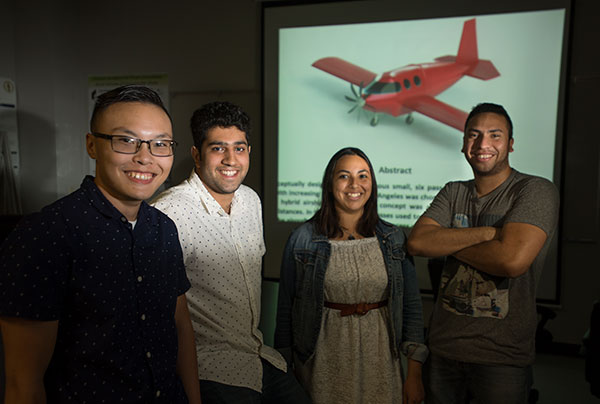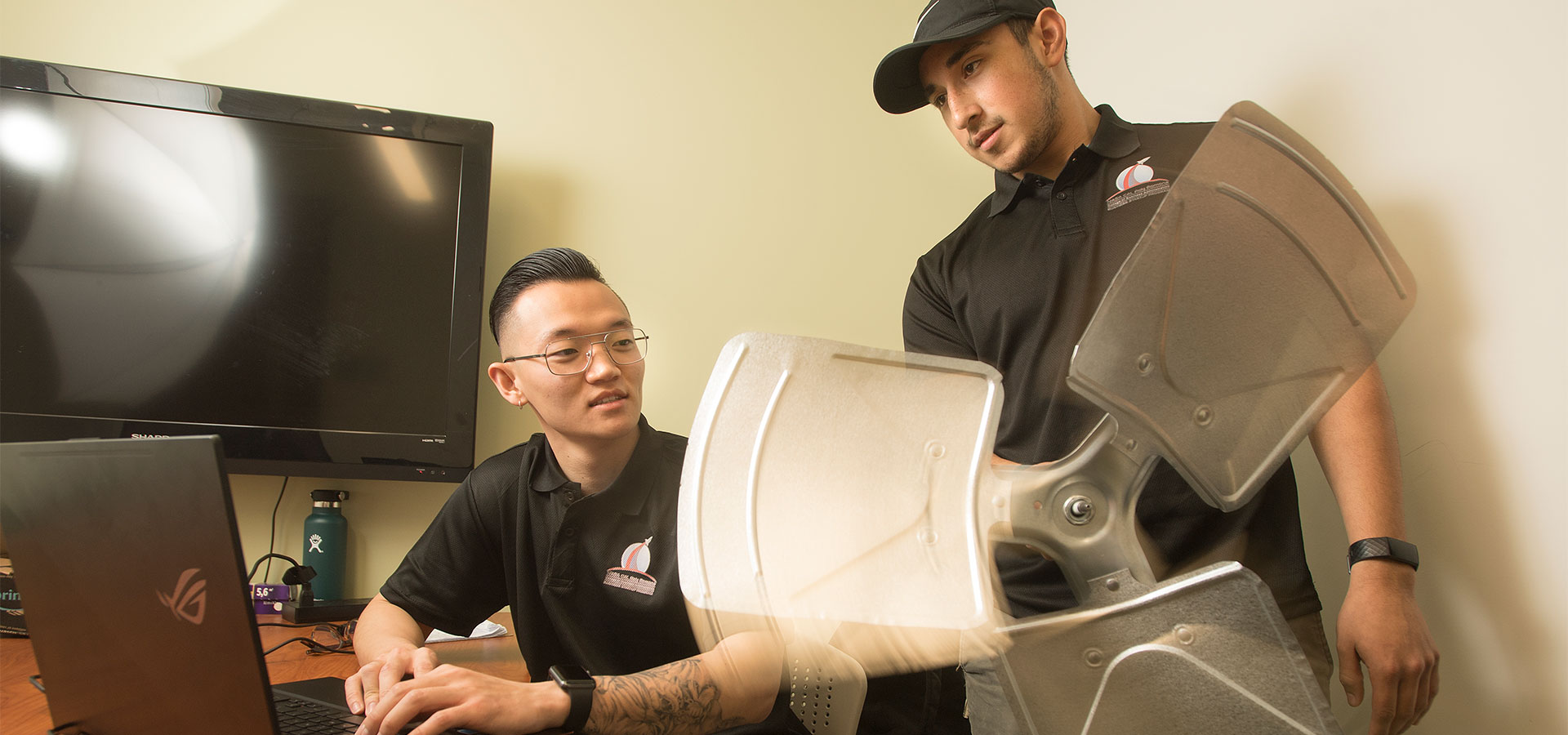Market Ready
NASA-CPP is getting closer to bringing its products to consumers like you
By Shelley Levitt
In the next two or three years, you might be able to improve your posture by slipping on Posturonic, an electronic vest-like device whose sensors will emit a pulse whenever you’re slouching.
If you’re shopping for the perfect birthday gift for a grade-school kid, one affordable option could be Lumoscope, a high-powered portable microscope that just might stimulate the child’s interest in STEM.
On the manufacturing side, companies might be able to decrease their heating or cooling costs thanks to a revolutionary new fan blade, tentatively dubbed AirFloLab, that blows 52 percent more air than traditional blades with the same amount of electricity and a lot less noise.
These widely disparate inventions have a couple of things in common. One, they are all built on or inspired by NASA technologies. And two, they were developed by CPP students.
Back in 2016 the NASA-Cal Poly Pomona Business Startup Program (NASA-CPP) launched with the mission of putting together multidisciplinary teams of students, faculty and mentors to identify ways NASA’s technologies could be adapted to consumer and commercial products. Over the years, the program has received several grants, won numerous awards and evolved its operations. “Our goal in the beginning was to create products directly from NASA technologies,” says H. Erkan Ozkaya, the founding director of the project and professor of innovation in the College of Business Administration. “But, as we discovered, you almost always need to modify space technologies to be feasible for consumer products. That’s why we’ve changed from using NASA technologies outright to being inspired by NASA technology.”
“Our goal in the beginning was to create products directly from NASA technologies,” says H. Erkan Ozkaya, the founding director of the project and professor of innovation in the College of Business Administration. “But, as we discovered, you almost always need to modify space technologies to be feasible for consumer products. That’s why we’ve changed from using NASA technologies outright to being inspired by NASA technology.”
Now the program is entering an exciting new phase of entrepreneurship. With funding provided by generous donors that include Al and Stephanie Tarkington, NASA-CPP is moving toward obtaining patents, forming a company for each product, finding investors and bringing the products to market.
“Donors are an essential part of our ecosystem,” Ozkaya says. “Our funding for research and development and scholarships for students come mainly from donors.”
The process from product idea to proof of concept through prototype and then to a refined product takes several years, with lots of trial and error.
August Brookwell is a biotechnology student who leads a team that’s working on an at-home product that can track how the body absorbs certain nutrients.
“I went into this program thinking I was just going to be doing some biology research. But I’ve gained so much more than I thought I would, getting to lead a team from different disciplines, including engineers, business majors and physicists,” he says.
Erika Sheppard, an Australian native, targeted Cal Poly Pomona and the NASA-CPP program because she has a product she wants to create. Now, majoring in business administration and computer information systems, she’s in charge of the Lumoscope project.
“What’s unique about this program is that it really brings together everything that you need to know for a product start-up,” she says. “You get to practice a very broad range of skills.”
Sitting among the students and their prototypes, Professor Ozkaya beams.
“All the students here are awesome,” he says. “I get so emotional about them. Both students and faculty put an insane amount of hours into this program, and I absolutely love it!”
At the Crossroads of Business and Science
Professor Erkan Ozkaya is Mentoring the Next Generation of Entrepreneurs
When Erkan Ozkaya was attending college in his home country of Turkey, he faced a dilemma familiar to many— what to pick as his major.
“I was really interested in science and also into business,” he says. “It was a tough choice to make.”
Ultimately, Ozkaya decided to major in business, graduating from Baskent University in Ankara with a bachelor’s degree in business administration in 2003, then his MBA from Yeditepe University in Istanbul, and going on to earn a Ph.D. in marketing from Michigan State University. In 2011 he joined the faculty at Cal Poly Pomona as an assistant professor of international business and marketing.
In a twist he couldn’t have imagined back when he was a young college student, today Ozkaya is fully immersed in the worlds of both business and science. Now, he is a professor of innovation in the College of Business Administration and the founding director of NASA-CPP, a start-up program where students and faculty across campus collaborate on developing consumer applications and products based on NASA aerospace technologies.
“I’m fascinated by innovation and love creating products and services,” Ozkaya says. “I have enormous respect for scientists and engineers, and now I get to work alongside them for NASA-CPP. It’s fantastic!”
The four-time recipient of the Faculty of the Year Award in the Department of International Business & Marketing department has led multidisciplinary teams of students, faculty and mentors in creating a wide range of products, from high-powered portable microscopes for kids to Posturonic, a posture correction device with sensors that emit signals whenever you’re slouching. Ozkaya was inspired to develop Posturonic because his own poor posture was making it impossible for him to sit in lotus position and meditate for more than five minutes at a time.
Now, with fresh funding from university donors, NASA-CPP is moving onto a new phase, patenting their products, with hopes of bringing them to market within the next few years.
It’s a big pivot from Ozkaya’s first job out of college, working for an Istanbul-based gaming company where he helped create and market a sports-betting service.
“While I really enjoyed that project,” he says, “I realized that I wanted to work in multiple industries and be involved with the big picture rather than focusing on only one enterprise, which turns into a day-to-day deadline grind after a while.”
The complex innovations Ozkaya is leading requires a vibrant ecosystem across disciplines.
“Nobody can succeed in sophisticated technologies in isolation,” he says. “Our ecosystem for the NASA-CPP program includes NASA advisors, CPP faculty and students and executives in residence, who are leaders in the tech and biotech industries.”
“Another vital element is potential investors, and we’re building relationships with venture capital firms in Silicon Valley,” he says. “The good news is that among venture capital firms that are used to dealing with Stanford and MIT, there’s a great deal of interest in what we’re doing at Cal Poly Pomona.”
Ozkaya estimates he spends at least 35 hours a week on NASA-CPP projects. He also teaches two classes each semester and oversees the annual Bronco Startup Challenge, a 13-week competition where student entrepreneurs formulate business plans and pitch their ideas to a panel of judges. As the director of Cal Poly Pomona’s new Center for Entrepreneurship and Innovation, Ozkaya is developing a series of workshops for entrepreneurs; he regularly publishes research in leading business journals on topics such as the impact of corporate reputation on emerging brands in India and China, and he is a committed mentor to his students, coaching them on career goals years after they’ve graduated.
“I don’t know if this is sustainable,” Ozkaya says with a laugh after reciting his ambitious to-do list, “but I absolutely love what I do.”
Philanthropy in Motion
Al and Stephanie Tarkington have both enjoyed long, successful careers. He’d graduated from Cal Poly Pomona in 1964 with a degree in business administration and had gone on to grow a thriving accounting firm, while briefly serving as mayor of Del Mar. After earning her education degree from Cal State LA, Stephanie worked as a special education teacher and had risen to become the principal of a large public middle school.
The Tarkingtons have always had an itch to travel. Unlike sedentary tourists, they prefer to do it peddling on a bicycle — a tandem bike for two to be exact. They have literally traveled the world biking through more than 40 countries.
“You are not sitting high in a tour bus. You are out in the fresh air connecting with the local people,” Stephanie says.
Al’s cycling (and the swim team at Cal Poly Pomona) has carried over into triathlons. In addition to many shorter triathlons, he has competed in 20 Ironman distance competitions, including 10 at the Ironman World Champion- ships in Hawaii. Ironman consists of a 2.4-mile swim, a 112-mile bicycle ride and a 26-mile run. Last year at 80, Al was the last athlete to cross the finish line. As always, Stephanie was his ardent and active cheerleader.
The Tarkingtons have long included Cal Poly Pomona in their estate plans, but in 2018 they increased their commitment to a
$1 million bequest to the College of Business Administration. This year, they’ve pledged $250,000 through the sale of a rental property to establish the Tarkington Family Fellowships in Entrepreneurship to benefit NASA-CPP.
As a retired CPA, Al says, “By donating appreciated property, I am able to donate the full value of the property and not the amount remaining after selling the property and paying income taxes on it.”
“We wanted to support students to do something that went beyond academics,” he says. “When I was a student, I was involved with the Rose Float, working alongside students from the engineering and agriculture departments. Cal Poly Pomona’s learn-by-doing approach was an important part of my education.”
Ever the dedicated educator, Stephanie adds that she’s impressed by Dean Erik Rolland’s vision for the college, especially when it comes to community outreach.
“The school is in the center of a somewhat underserved population,” she says. “They’ve been working with high schools to bring students on campus so they can have a college experience and understand what it could mean for their future. That kind of support is vital in enabling students to really reach their full potential.”


